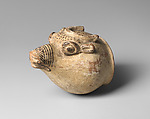Vessel
Old Assyrian Trading Colony or Hittite
Not on view
This ceramic vessel, probably from Kültepe is one of many drinking vessels found in domestic and burial contexts at the site. The vessel is in the form of a ram’s head, and its exterior was treated with cream slip before being decorated with black paint on the snout, forehead, horns and top of head. The modelled eyes and ears are outlined in black and the interior is unpainted and undecorated. Zoomorphic drinking vessels and rhytons, which were specifically used for pouring liquid libations, date back to the 7th millennium across the Near East but flourished especially in Anatolia during the second millennium B.C. The repertoire of such vessels found at Kültepe include animals such as lions, antelopes, rabbits, dogs, boars, snails, eagles, and partridges but other shapes such as human heads and upturned boots (67.182.2) also exist. These whimsical forms, rendered through modelling, relief, and painted decoration illustrate the artistic creativity and technical prowess that flourished in this cosmopolitan city during the Middle Bronze Age (2000-1600 B.C). Roughly contemporaneous texts from the Syrian city of Mari reference bibru, zoomorphic-headed vessels made from precious metals that functioned as diplomatic gifts. The Hittites later adopted this term to refer to zoomorphic and non-zoomorphic vessels made from various materials, some of which functioned as rhyta. Hittite bibru were fundamental to cult ritual and certain animals could be associated with specific deities. The zoomorphic vessels at Kültepe represent a possible earlier manifestation of this tradition, made from clay and used in domestic contexts.
Due to rights restrictions, this image cannot be enlarged, viewed at full screen, or downloaded.

